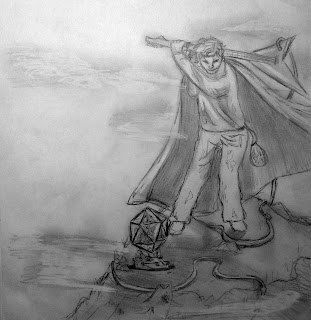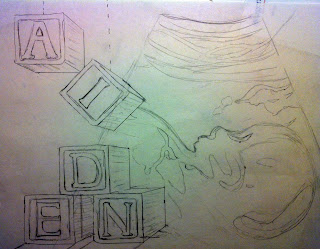"Acolytes of the Machine" Starr Weems. 15x15 Transparent watercolor on 140 lb. paper.
I was excited when
Mary Crowell commissioned me to do the cover work for her new gaming-inspired solo album. It isn't often that I work with a client who has such a clear vision of what she wants for the final product. What did Mary want for her cover? An ornate, fantasy organ with multiple ranks of pipes, a dark-haired organist with her face reflected in a mirror and creepy stone children singing, all with a slight steampunk feel. Here is the process I went through to get to the image above.
Step one: Research and sketch ideas
The first part of my research is to read the
lyrics to the song that goes along with the image. I want to make sure that I understand the feel of the piece. I don't remember what a pipe organ looks like, so I also spend lots of time looking at pictures of different styles. I sketch out thumbnails of possible painting compositions.
Step two: Develop one of the thumbnails
I choose the thumbnail I like the best and develop it into a preliminary sketch.
I send the sketch to Mary for review. She confirms that we are headed in the right direction and has some suggestions on changes she would like.
Step three: Revise the sketch
I spend some time playing with the images and moving some things around. I send it back to Mary. Ding, ding, ding! We have a winner.
Step four: Create a clean sketch for paper transfer
I start from scratch on a new sheet of paper and redraw the image, making minor adjustments and leaving out any shading. This is the image that I will use to transfer to the watercolor paper. I go to Staples and have this picture enlarged from 9x9 to 15x15.
Step five: Create a value sketch
With watercolor pouring, it is especially important to have the value placement mapped out in advance. I complete a value sketch so that I know exactly where to paint the drawing gum.
Step six: Correct an unforeseen problem
With the value sketch complete, a problem with the design becomes apparent. I want the organist and the background to appear as two separate but related images. This way, I can capture both the looming quality of the ranks of pipes and the detail of the console. The adjustments that I made to the preliminary sketch have made the organist and pipe ranks too cohesive. I need some way to separate the console and the background.
I put a piece of tracing paper over the value sketch and try different solutions. Adding a cloud of steam around the organist seems to work the best. I show the addition to Mary and she adds that she would like for the steam to be thin and wispy so that it does not obscure the creepy, glowy-eyed children.
Step seven: Transfer the image
I transfer the image to the watercolor paper using a graphite transfer sheet.
The copy that I am tracing from is very low quality because Staples ran it off on their blueprint machine, but I have the value sketch to reference.
Step eight: First pour
I mask the brightest values with drawing gum and pour the first layer!
To make sure that the steam is wispy, I decide to use a paper towel to lift out the color on each layer that I pour.
Now I set it aside to dry for a few hours.
Step nine: Second pour
Following my value sketch, I mask out the next lightest values with the drawing gum.
I am ready to pour the second layer.
I get impatient this time and dry the painting with a hair dryer so that I can get another pour in before the day is over.
Step ten: Third pour
I mask the next lightest value with the drawing gum.
And pour...
I let it dry. I think one more layer will do the trick.
Step eleven: Fourth pour
I mask and pour the final layer.
I really, really want to be impatient and remove the masking to see what my picture is looking like underneath, but I wait because I know I will be heartbroken if I jump the gun and rip the paper.
Step twelve: Remove drawing gum
Finally! The piece is dry and I get to remove the drawing gum with a special eraser.
Now I can see what I have to work with.
The lines are rough and there are no details painted in yet.
Step thirteen: Scrub
I use a scrubber brush and a melamine sponge to soften the lines and move some of the paint around.
Now I have all of the scrubbing finished and the piece is ready for some direct paint.
Step fourteen: Add detail with direct paint
I add some detail...
And more...
And more...
I'm finished! I send the image to Mary for review and she loves it. Now I am all set to work on the back cover of the album.
























































